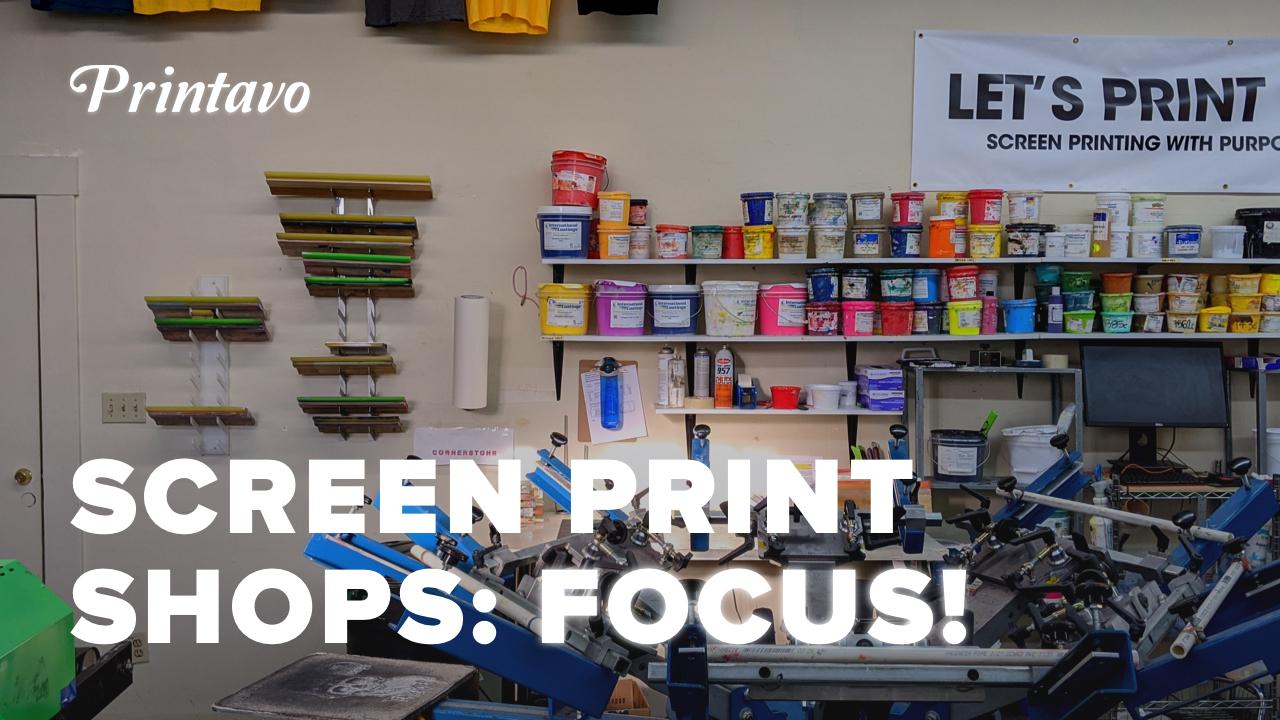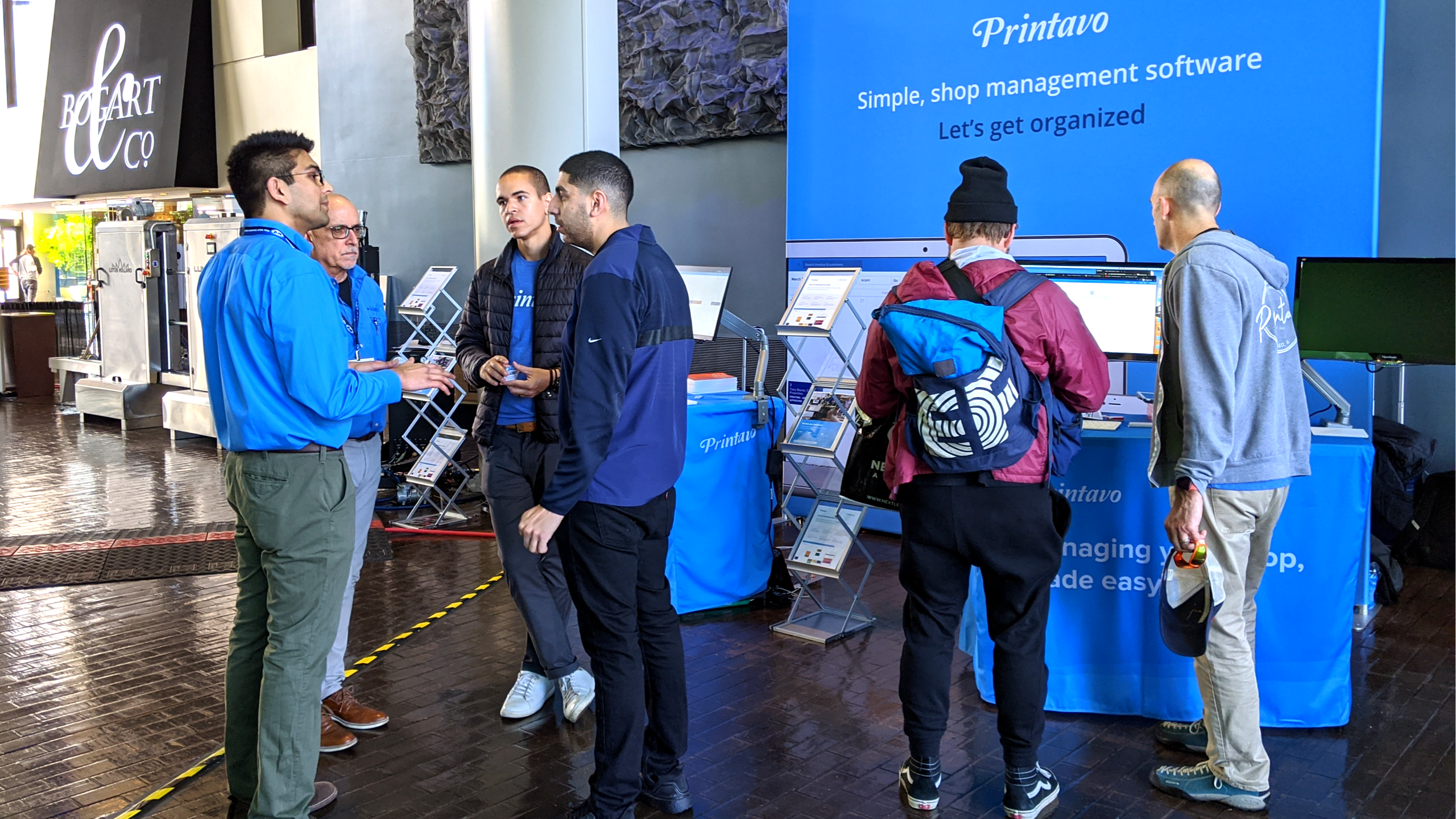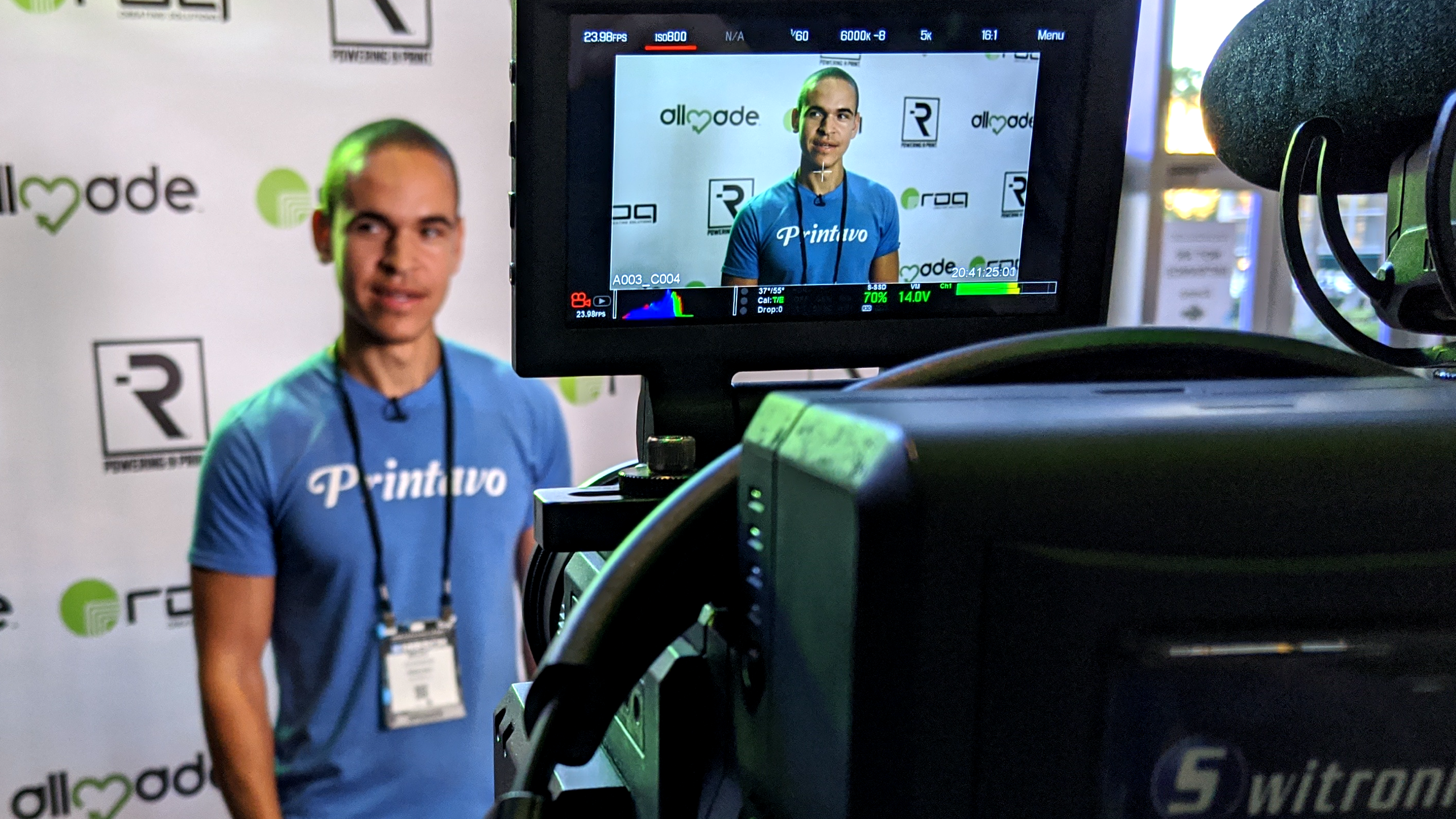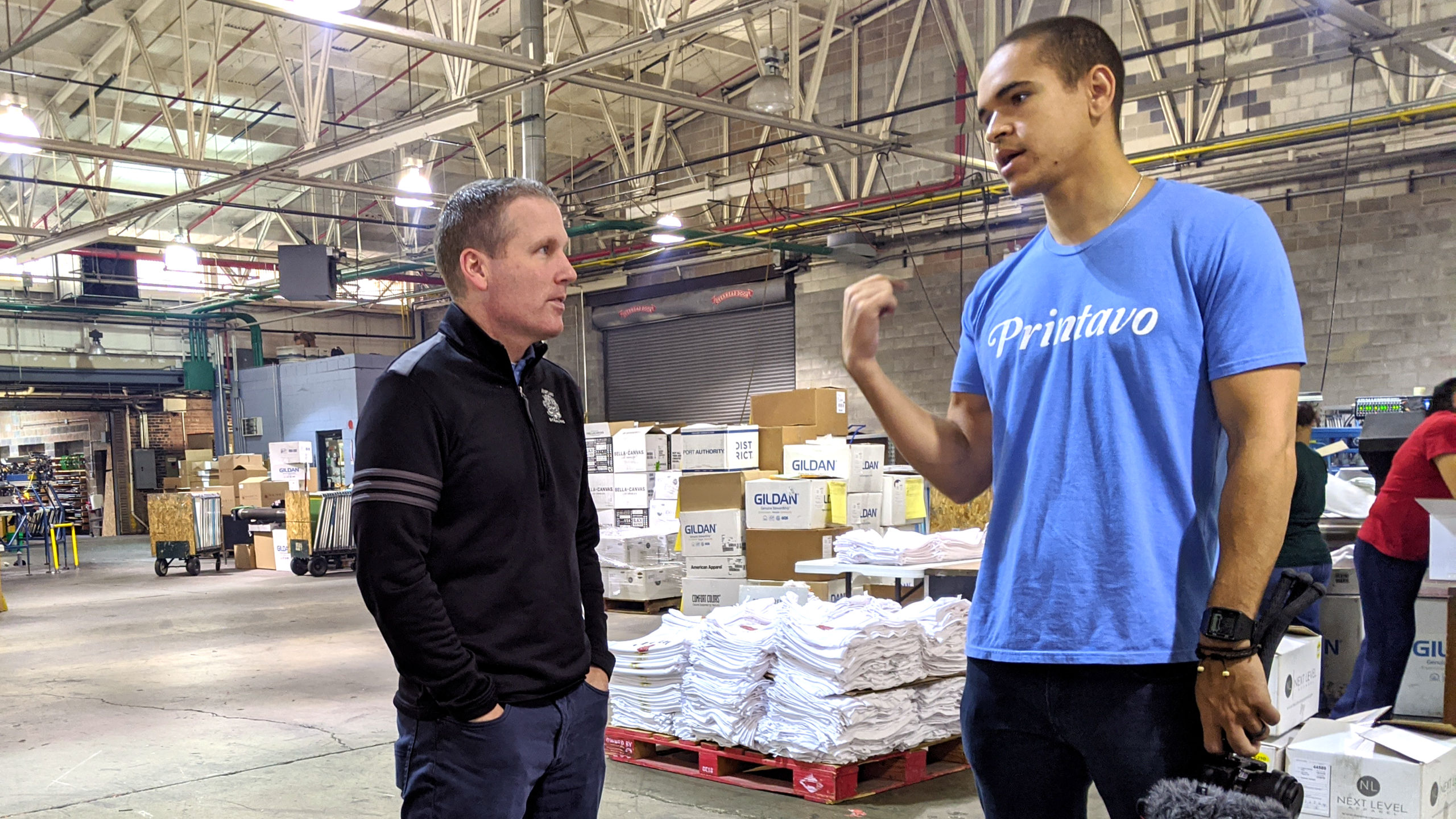What’s the biggest downfall for most screen print shop owners? It’s a lack of focus.
This happens several ways:
- Owners are spread too thin. They’re answering too many questions, causing extreme distraction
- Owners are doing tasks they’re not good at. Worse, they’re stuck doing tasks they don’t even like
- Owners are not focused on high-value tasks. They’re really busy…but not doing things that will actually help improve the business
- Owners are focused on short-term fixes and problems. They’re just trying to get through the day – not focused on achieving long-term goals
Screen printing is a notoriously difficult industry. There are genuine barriers to growth and improvement. From garment suppliers, low margins, misfit customers, difficult employees, to a lack of industry standards – there’s no lack of headaches.
I sat down with Steven Farag from Campus Ink to talk candidly about how hard it is to own a business. It’s not easy, and we both struggle to know exactly how we should best spend our time. Campus Ink has doubled in size during a short period of time – just like Printavo – so this conversation helped us work through our struggles.
There are common, widespread problems throughout the screen printing industry. But a lack of focus is the primary challenge for many screen print shop owners. Way too many screen print shops are trying to be everything to everyone because they can put virtually anything on a t-shirt – but that’s a mistake.
If you see “Long-Term Goals” and think you’d be relieved to just make it through the day (much less the week), then this article is for you.
Tips for focusing in your screen printing business
Attention and long-term focus are not out of reach. But you’ve got to take steps to prevent getting bogged down with day-to-day tasks.
There are a few things you can do to keep yourself focused on the really valuable long-term tasks in your screen printing business. Here’s what we’ve found:
Track what you actually do
Instead of putting out fires, write down what you intend to do for the day. If you actually do something else, write that down too. “I make a to-do list on my phone…but when the day starts, those tasks can take a long time. It’s a tug-of-war for my attention and time,” Steven says. Why do this? You’ll learn how much you’re really getting done – and where your energy is really going.
Make space and time to work at your best
Where are you most productive? When can you really get the most done? “My most productive days might be on the couch or in a coffee shop,” says Steven. With loads of distractions to capture his attention, Steven has to carefully pick and choose the time and space to do his work. “I’m a late night worker. My best work is at 2 AM. But I’ve found that super early morning work is the best I have. When it’s quiet. When there are no distractions. I’ll just knock out big things. Answer a lot of emails. Answer important emails. Get ahead of the chaos.” Personally, I need to relocate during the afternoons – and can definitely get more done when I’m in a quiet space with lots of natural light.
Leave the print shop
When a day goes well, leave the shop around noon. Does that sound scary? Steven explains how he talked himself into this: “Let it go. See what happens. The employees don’t want an owner that is always over their shoulder.” Use that time to focus on the things that can really deliver value. You’ll also discover the areas that need improvement.
Find a way to be accountable to the team
“The self-awareness [that you’re a small business owner] is crucial. If you don’t write down your tangible goals for the next 90 days and create some accountability…you are not accountable to anyone.” says Steven. That sounds like freedom, but the truth is that you are ultimately accountable to your employees and the model for meeting goals that you establish.
Use Do Not Disturb mode and tune out distractions
Whether on your iPhone, laptop, or Android device…silence your alerts. “During Campus Ink’s busy season I had 2,000 different notifications a week from. I didn’t want to miss anything, so I’d turn on every notification,” Steven told us. “We want to be superheroes and attend to everyone’s needs,” he continues, “That superhero dilemma is tough, because you have to stop and put things on paper, and tell people they’ll be in charge of certain things.”
Use browser plugins
Need to focus for a while? Want a little nudge to help? There are actually a couple great browser plugins to help you with that. Try these productivity tools for Chrome:
- Just Focus
- BlockSite
- Tracking Time | Button
- Focus To-Do: Pomodoro Timer & To Do List
- Rescue Time
Accept your limits: document tasks and procedures
You’re no superhero, even if you want to be! “We want to be superheroes and attend to everyone’s needs,” Steven says. He continues, “That superhero dilemma is tough, because you have to stop and put things on paper, and tell people they’ll be in charge of certain things.”
Editor’s note: The Pomodoro Technique is a great technique for getting a lot done through short bursts of work. It’s not always best to sit down and try to work for hours on end. Pomodoros are 25-minute chunks of time where you consciously focus on one task. Typically, it will take multiple “Pomodoros” to get a task done – you may even start saying things like, “That’s a 5 Pomodoro task.”
Use software like Printavo
The entire reason we made Printavo is to help screen print shops get organized. Simplifying a complex series of tasks like the screen printing process is no easy job. The earlier you implement systems, processes, and a foundation to grow your business off – the sooner you can grow and delegate.
Read Traction and actually implement its advice
We can’t recommend Traction by Gino Wickman enough. It’s chock full of interesting exercises. Skip the audiobook and actually buy the paperback – you’ll want to draw all over this book thanks to its interesting, almost coloring-book-like diagrams and worksheets.
Document everything – particularly questions you get a lot
Write down the questions you get a lot. These are the ones that you can get the most value from by crafting solutions for that are obvious: checklists, standard procedure guides, large visual instructions, etc. Why? It’s hard to truly manage multiple people. You can only genuinely directly manage about eight people before you’re half-assing everything else. Sales, front office, pre-production, printers, in my case engineers – they’re all going to you. There is no one else! They need you to have solutions ready. Simply keeping a FAQ or a spreadsheet with questions you commonly encounter can help a lot.
Be self-aware about how you’re treating your time
“Big companies have executive assistants. These are amazing people that keep the executive on task. They can protect their time as well. If you look at a massive company, someone has to filter their emails. The CEO cannot physically be everywhere at once. There needs to be a little firewall around them,” Steven explains. It’s necessary to create a strong barrier for yourself sometimes – don’t be afraid to protect your time and say no!
Know the focus formula
Poor delegation and poor understanding of the business
+
Lack of self-awareness about how you’re spending time
=
Poor focus on what matters most
“I’d be scared to see what I actually do on my computer”
We’ve all been distracted during brief moments of downtime.
A website is taking a while to load, so you pop open a new tab and check out Facebook. Suddenly, fifteen minutes have evaporated and you’re not even sure what you were supposed to be doing anyway. But in those fifteen minutes, five new notifications have appeared on your phone with questions from your team.
So how does a small business owner – ultimately not accountable to anyone except themselves – craft a system to stay focused?
“It comes down to discipline. Struggle with that? Be accountable to someone. There must be something keeping me on task,” Steven says. There are a handful of ways to hold yourself accountable, even if you’re really the boss:
- Hold 90-day check-ins with the entire team. Have an open conversation about where you are and where you’re going.
- Lean on productivity software to keep yourself on task. There are lots of browser plugins and productivity tools. Even if you just use a notes app to write down what you do, use some kind of software to keep yourself organized.
- Be self-aware enough to probe your time. It’s hard to see that your time isn’t being spent well. So be ready for some challenging truths to emerge when you start tracking your time.
- Answer questions “once and for all.” Don’t waffle on your answers to policy and procedure questions. Once you decide, stick with it…and write it down!
If you’re spending most of your time putting out fires, you’re slowing down your team and hampering your shop’s growth. You need to spend time on things that deliver big returns in the future – think about laying the foundation for success three to five years down the line.
When you’re not using your energy on activities that yield big returns in the future, you’re suffocating your business. If you’re doing busywork like shipping, delivering, and filing paperwork, then you should look for ways to delegate.
A lack of delegation creates busy work. Low-value tasks are distractions…eliminate them!
“We want to be superheroes!”
So what are the high-value tasks that you should spend your time on?
You can’t just work 80 hours a week and brute force your way through growing your business. Ambition does not scale up. You are just one person.
Decisive action toward tangible goals is what’s required to make progress. That doesn’t mean pouring more energy and hours into the same tasks you already do.
Instead, think about three main areas where you can make a big influence:
- How can I document what needs to be done – so that someone else could do any job in the shop? You aren’t replaceable. But someone else needs to be able to do the job. Clearly documenting your shop’s procedures and processes (or revising them) is invaluable.
- What is really happening with your finances? Dive deep into your finances. Revenue management – understanding where you’re actually making and losing money – is a high-value task for any size shop.
- What are the Big 3 tasks that only you can accomplish? The Big 3 areas you love to work in, are great at, and can truly succeed in – focus there. Delegate the rest. Seriously: pick three BIG things you can do, and only do those things!
The most high value tasks a screen print shop owner can do are:
- Crafting standards and procedures
- Sales, marketing, and branding
- Community outreach
- Hiring, interviewing, and vetting
- Managing people and delegating tasks
- Financial management
- Crafting long-term plans and determining how to execute them
- Visiting customers
- Investing in art and artists
- Improving processes within the shop
- Learning about new equipment and techniques
- Doing post-mortems on jobs that weren’t profitable or had errors
- Eliminating excess tasks or waste
- Getting help on problem areas in the business
Note the things that aren’t here: printing, answering tiny questions, responding to emails, writing quotes, returning minor phone calls.
Maybe some of those things are your strengths – you’re a Print Hustler and can get anyone to close a deal on the phone, perhaps – but that just might not be as high value as doing things that only you, the business owner, can do. That’s a bitter pill to swallow, particularly if you need to do something you don’t actually like doing.
But even things you dislike that you must do for the business can be delegated: accounting, tax preparation, HR…there is no lack of help. You just have to identify where you need help and seek it out.
Ultimately, you want to find the things that meet two criteria: you really good at and really want to do them…and they’re actually valuable for your business.
Screen print shop owner: you are a superhero! But you’re human, too. Plan accordingly – this is a long journey and you’ll need all your energy!
“If you cloned yourself, would you be happy with their work?”
Here’s a fun (or perhaps scary) thought: would you be happy with your own clone’s work?
Here’s a dose of the harsh truth: for all of the demands we put on our employees, we often miss our own failures and shortcomings. While accountability is great, you really do have to put the onus for improvement on yourself. If you’re just chasing your tail and going through the motions, you’re not focused on actually improving. You’re just struggling to stay afloat, even if the business isn’t in any real danger.
“If you get defensive about your work, that’s when it’s time to really examine what you’re doing,” Steven says.
We may be small businesses in the grand scheme of things. But that’s no long-term excuse as a leader. Small business owners tend to rely on that excuse…but a year later, you’re making the same excuse. Then another year passes and nothing has changed.
Ask yourself: what really needs to happen in the next three months? Then, look back once you get there – are you happy with the progress your employee (i.e. you) has made? “April 15th is a tangible deadline for me to look at my goals, and it’s coming right up,” Steven says.
If you’re constantly distracted, answering small questions, and lacking focus, you could look back and regret making so little headway on the truly important projects that you want to accomplish.
“It’s a classic dilemma,” Steven explains, “It hurts me to tell my staff to take their small question to another person. It feels like telling a little kid, ‘Go somewhere else, because I am doing more important things right now.’ But it’s necessary. It allows you to focus on big things.”
“Can you summarize your focus for each year?”
If you had to summarize your focus for each of the past five years, could you do it?
If you’re like us, you’ll struggle to answer that question. There’s so much happening, so many problems to solve, and so many moving pieces that it feels like real focus is impossible. Traction can help you here.
Here’s the thing: focusing is not impossible.
Screen print shop owners have a huge advantage: they have the luxury to choose a niche and focus on it. This is powerful! You can spend your marketing and sales efforts on specific customers that you want to work with, develop processes to print the way you want to print, niche down and focus the entirety of your operation on a handful of strengths.
The biggest takeaway
You don’t have to be everything to every customer. And you shouldn’t try. Focus!
Screen print shops thrive when they focus on the right customers, the right message, and the right goals to propel the business forward. If you can summarize your focus for the next year in a single sentence, you’ll be armed with a powerful tool to help you understand what you should do next. It makes every decision along the way that much easier.
Enjoyed this? Read my article about how to work on your screen printing business for more.
Join Printavo’s amazing community (including Steven Farag) at PrintHustlers Conf 2020, an elite conference for the best and brightest in the custom apparel industry. Now in its fourth year, PrintHustlers Conf has brought shops from across the world (even Nigeria!) for two days of incredible presentations, seminars, and relationship building.
If you want to meet the industry’s biggest players, learn from the best, and have a blast at an incredible venue with truly inspiring people, then Printavo’s 2020 PrintHustlers Conf is where you want to be.
Where: Ace Hotel in Chicago
When: July 24-25, just after the ASI Chicago show.
What: A gathering of the industry’s finest for candid discussions and solution building (and some fun, too)
Curious to see what PrintHustlers Conf is like? Check out PrintHustlers Conf 2019 on YouTube with last year’s presentations and breakout sessions or read our in-depth recap of PrintHustlers 2019. Also, we owe a huge thanks to Ryonet, Allmade, M&R, Next Level Apparel, Supacolor, and Clubhouse Athletic for sponsoring PrintHustlers Conf 2019.
Note: A majority of the tickets have already sold … and we are months away from the event. Do not wait to get your tickets to PrintHustlers 2020 – this event will sell out soon.







0 Comments